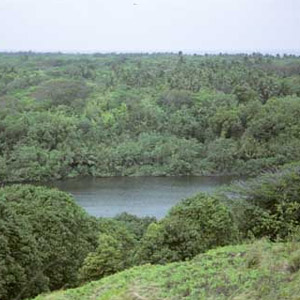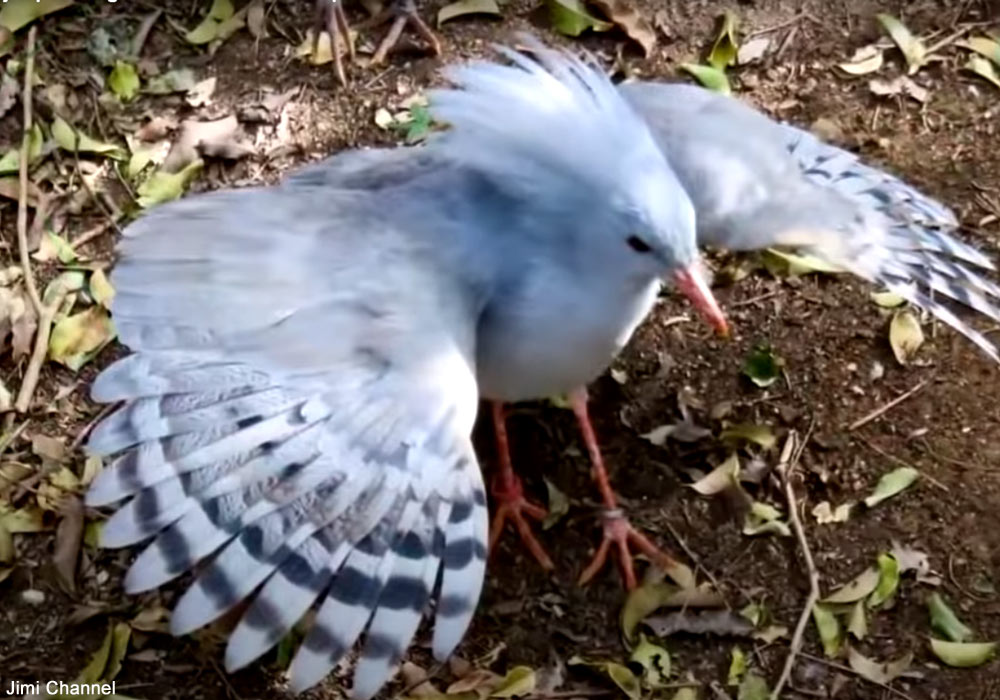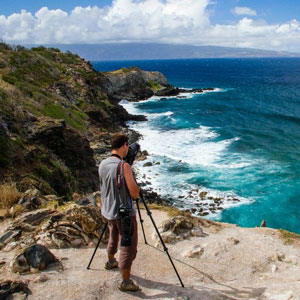Magazine | Voyages
Observer les oiseaux endémiques des îles Cook

Vue de l’île d’Atiu, dans l’archipel des îles Cook, où des Loris de Kuhl (Vini kuhlii) ont été transférés en 2007.
Photographie : Angela K. Kepler / Wikimedia Commons
Introduction
L’archipel Cook est constitué de quinze petites îles dispersées dans une zone du Pacifique Sud presque équivalente à la taille de l’Europe de l’Ouest. Elles se divisent en deux groupes, les Cook du Sud (six îles) et les Cook du Nord (neuf îles).
Sur ces terres isolées vivent plusieurs espèces d’oiseaux terrestres endémiques, dont la plus connue est peut-être le Monarque de Rarotonga (Pomarea dimidiata). Certaines ont disparu, du fait de la chasse, de la destruction de leur habitat ou de l’introduction de rongeurs : c’est le cas du Lori de Kuhl (Vini kuhlii). En avril 2007, 27 oiseaux ont été transférés sur l’île d’Atiu à partir d’oiseaux de Rimatara, en Polynésie française.
Dans cet article, nous vous proposons une présentation de l’avifaune de cet archipel peu connu, ainsi que du programme de réintroduction du Lori de Kuhl. Nous remercions Gerald McCormack du Cook Islands Biodiversity Trust pour nous avoir transmis les informations et les photographies de cet article.
Abstract
The Cook Islands is composed of fifteen small islands (total land area of 240 km²), scattered over an area approaching the size of Western Europe, in the Southern Pacific Ocean.
The fifteen islands divide socially and physically into a Northern Group of six islands and a Southern Group of nine islands. The five atolls and one sand-cay of the Northern Group, support extensive Coconut Palm plantations for a fickle copra industry. The only resident landbird is the Pacific Pigeon (Rupe), which lives on three atolls.
The Southern Group, with 90% of the land and 90% of the population, is physically diverse with a young volcanic island (Rarotonga), four raised-reef islands (Mangaia, ‘Atiu, Ma’uke and Miti’aro), an almost-atoll (Aitutaki), two atolls (Manuae and Palmerston) and a sand-cay (Takutea). The birds of special international interest are the six endemic landbirds, which are all listed as « Vulnerable » or « Critically Endangered » in BirdLife’s Birds to Watch 2. The other bird of special international interest is the introduced Blue Lorikeet, which is endemic to neighbouring French Polynesia.
Several endemic species have already disappeared in the past, including the Rimatara Lorikeet (Vini kuhlii). Twenty-seven lorikeets (‘Ura) were reintroduced to Atiu, Cook Islands, from Rimatara, French Polynesia, by a direct international flight between the two islands on 24 April 2007.
We thank Gerald McCormack from the Cook Islands Biodiversity Trust for transmitting the informations and the rare photos of this article.
Poursuivez la lecture de cet article, en vous abonnant dès maintenant !
Découvrez les Archives d’Ornithomedia.com
Pour seulement 10,00 €TTC/an (ou 6,00 € les 6 mois)
Profitez de plusieurs centaines d’articles en accès illimité et sans aucun engagement.
Compléments
À lire aussi sur Ornithomedia.com
À la recherche du Cagou dans le parc provincial de la Rivière bleue (Nouvelle-Calédonie)
À lire sur le web
Le site web du Cook Islands Biodiversity Trust : http://cookislands.bishopmuseum.org
Ouvrages recommandés
- Birds of Melanesia – Bismarcks, Solomons, Vanuatu, and New Caledonia de Guy Dutson
- Birds of the Solomons, Vanuatu & New Caledonia de Chris Doughty (Auteur), Nicholas Day (Auteur), Andrew Plant (Auteur)
- Lonely Planet Rarotonga & the Cook Islands de Oliver Berry (Auteur), Errol Hunt (Auteur)
- Cook Islands (Carte)
Sources
- BirdLife International. 2004. Vini kuhlii. In: IUCN 2006. 2006 IUCN Red List of Threatened Species
- BirdLife International. 2006. Species factsheet: Vini kuhlii
- Blanvillain, C. 2002. Oiseaux de Rimatara et des Australes. Te manu (Pape’ete, French Polynesia) 41:9-10
- Fritch, E., Howell, P., and Grand, S. 1996. ERRETE n 296 CM du 18 mars 1996 inscrivant certaines espèces sur la liste des espèces protégées relevant de la catégorie A. Journal Officiel de la Polynesie Française 28 mars 1996:516
- Kuehler, C., Lieberman, A., Varney, A., Unitt, P., Sulpice, R.M., Azua, J. and B. Tehevini. 1997. Translocation of ultramarine lories (Vini ultramarina) in the Marquesas Islands: Ua Huka to Fatu Hiva. Bird Conservation International 7(1):69-79
- McCormack, G. and Kunzlé, J. 1994 Le ‘ura ou lori de Rimatara (Vini kuhlii): sa répartition passée, son statut actuel, et les priorités pour sa protection. In MANU. 1994. SEMINAIRE MANU Connaissance et protection des oiseaux; 9, 10, 12 Novembre 1993, Punaauia, Tahiti. La societe d’ornithologie de Polynesie, Papeete, Tahiti
- McCormack, G. and Kunzle, J. 1996. The ‘Ura or Rimatara Lorikeet Vini kuhlii: its former range, present status and conservation priorities. Bird Conservation International 6:325-334
- McCormack, G., Evans, J., Rongomatane Ariki, and Mariri, T. 2000. ‘Ura or Rimatara Lorikeet Survey 200. Unpublished report, Cook Islands Natural Heritage Trust, Rarotonga
- McCormack, G. (2006) Rimatara Lorikeet Reintroduction Programme
- OIE. 2007a. Animal Disease Overview for Cook Islands
- OIE. 2007b. Animal Disease Overview for French Polynesia
- Sanford, G. and Raust, P. 2002. Oiseaux de Rimatara. Te manu (Pape’ete, French Polynesia)
- Thibault, J-C. 2005. Liste des espècies d’oiseaux de Rimatara. Unpublished report to the Délégation à la rescherche, Papa’ete, French Polynesia
- Watling, D. 1995. Notes on the status of Kuhl’s Lorikeet Vini kuhlii in the Northern Line Islands, Kiribati. Bird Conservation International 5:481-489







Aucun commentaire sur ce sujet
Participer à la discussion !